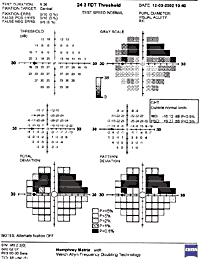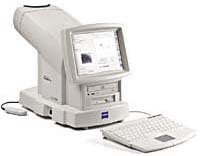Peripheral visual field testing rarely necessary or useful
|
|
Perimetry and visual field testing are important diagnostic tools for detecting, evaluating and monitoring ocular and neurologic disorders affecting the visual system. Peripheral visual field loss may be useful in detecting eye diseases such as glaucoma, and the pattern of loss can be helpful in differentially diagnosing various other ocular disorders.
The following questions arise: Is there a need to assess the peripheral visual field to establish a diagnosis? Can central visual field testing suffice?
This question is important because many optometrists are considering the purchase of one of the newer perimeters, such as the frequency-doubling technology (FDT) Humphrey Matrix (Carl Zeiss Meditec, Dublin, Calif.), Octopus 300 series (Haag-Streit, Mason, Ohio) or Oculus Easyfield (Woodinville, Wash.). These perimeters test only the central 30°, as compared to the Goldmann, original Octopus and Humphrey HFA II perimeters, which evaluate both central and peripheral fields.
The optometrist is faced with an intriguing set of questions as he or she considers an instrument that evaluates only the central field. These questions include the following:
- Will a clinician be providing suboptimal care if he or she uses an instrument that tests only the central field?
- Will ocular diseases be overlooked when only the central field is evaluated?
- Can a defect show up initially in the peripheral field that requires a peripheral test for its detection?
- If we are evaluating the peripheral field, should we use a screening or thresholding algorithm?
|
|
Visual loss usually in central field
The visual field encompasses about 100° to the temporal side, 60° nasally and superiorly and 75° inferiorly. In conditions in which the optic nerve is damaged, such as with glaucoma or a disease of the central nervous system pathways (neurologic visual field loss), visual loss takes place in the central field (defined as out to 30°) and may extend outside this area. The clinician must determine which portion(s) of the visual field should be evaluated during the ophthalmic examination to detect visual field defects.
The take-home message of this column is that it is most important to test the central 30° radius of the visual field. Evaluation of the peripheral visual field beyond 30° is not clinically useful, except in rare circumstances. Such rare circumstances include the differential diagnosis of eye disease or for better characterization of visual field loss.
There will be cases in which the peripheral field is abnormal and the central field normal. Still, visual field loss occurs either initially or at the same time in the central as compared to the peripheral field in the vast majority of cases. Studies have reported that between 91% and 99% of all visual field defects will be detected with the evaluation of the central field. Our interest in testing the peripheral field has declined as we have become aware of its characteristics.
Significance limits
The significance limits for the peripheral field are wide and nothing like the central field. Thus, it is difficult to discern the abnormal from the normal response. It is a question of pain vs. gain. Due to the time needed to examine the periphery and the lack of diagnostic precision, the standard of care has been to examine the central field.
Only a very small percentage of field defects will not be detected using central visual field testing. Those defects may be revealed by evaluation of the periphery, testing beyond 30°. Thus, the routine evaluation of the peripheral field is not usually helpful and will more than double the testing time with minimal improvement in the detection of defects. Only a small number of ocular disorders produce visual field losses beyond 30° without involvement of the central field, and these conditions are rare. Thus, the central visual field is the most important and useful test.
Conditions with peripheral defect
|
|
Conditions that may have only a peripheral defect include retinitis pigmentosa, a retinal detachment, other retinal disorders or rare neurologic conditions. For a retinal condition, a dilated binocular ophthalmoscopic retinal examination, not a visual field evaluation, is the preferred method for detection.
If a patient has symptoms associated with a retinal condition (i.e., flashes), a dilated retinal examination is the best testing choice. Also, while it is important to assess the visual field as part of every comprehensive examination, the most significant gains will be with a central field evaluation. To further assess the peripheral field on a routine basis will lead to few additional disorders being discovered and will prolong the examination unnecessarily.
The yield if we routinely test the peripheral field approaches the sensitivity and specificity limits of a standard field test, so we’ll have as many false positives as true positives, even if we are testing a population that is 50% true glaucoma. If we are testing a population with 1% true glaucoma, we will have 100 times as many false positives as true positives (10% false-positive rate among normals vs. 10% of 1% true glaucoma). In this case, it is easy to see why routine testing of the periphery would not be efficient. The number of visual field defects missed by not testing the peripheral field will be miniscule, but the amount of time saved is substantial.
Threshold evaluation
Threshold evaluation of the peripheral visual field is not usually helpful due to its different characteristics as compared to the central field. The central field is the most sensitive portion of a person’s field of vision and is the most repeatable with regard to variability. A wide range of scores may result when peripheral points are tested repeatedly. Each of the scores may be entirely normal and, due to the peripheral test point’s locations, not pathologic.
Variability increases as sensitivity declines. Because the peripheral field is less sensitive than the central field, it has greater variability. The increased variability limits the usefulness for thresholding the peripheral field because the confidence limits are large and there is a significant overlap between normal and abnormal individuals.
Range of normal sensitivity
Another issue with the peripheral field is the range of normal sensitivity. Different ethnic groups may have different anatomic structures of the eye and orbit, which affects the peripheral field. For example, prominent brows or a prominent nose may reduce the peripheral field’s dimensions, which can cause interpretation difficulties and yet be entirely normal.
Peripheral screening test
If the peripheral field is evaluated, the best approach may be to use a screening test. While peripheral threshold tests such as the 60-2 or 60-4 are included in the HFA II perimeter, they are not commonly used. These tests go back 20 years when full threshold was the algorithm of choice and the understanding of the peripheral field was not what it is today.
Screening provides information as to whether a test location is within the expected normal range but does not quantify a location. Screening tests are efficient and quick, because they test only each location once or twice. SITA Standard and Fast are relatively new tests with few data available on how well they may perform if used in conjunction with peripheral test patterns. Future research is needed to illustrate their clinical capabilities.
When peripheral testing is necessary
There are a few clinical situations that would require testing of the peripheral field. These include a driver’s license examination that requires the evaluation of the peripheral field or a patient with a questionable neurologic visual field defect that is not illustrated clearly with central testing. Canada has a requirement that a person’s visual field be 120° in the horizontal dimension as well as 15° above and below the point of fixation to qualify for a license.
The evaluation of ptosis does not require a peripheral test. A central test, which documents constriction to within 15°, will document functional involvement due to the lid droop. Many normal elderly individuals have a reduced central 30-2 field due to lid lag and are not candidates for ptosis surgery. A functional problem does not arise until the superior field is reduced to less than 15°. Looking at the periphery is not specific to the question at hand.
Few disorders affect the periphery
A perimeter that evaluates only the central field will meet the perimetric needs for most clinicians. There will be few situations that require the evaluation of the peripheral field. Between 91% and 99% of all visual field defects occur within the central 30° radius of the visual field, and few visual field losses are present exclusively beyond the 30° radius.
Only a small percentage of retinal and neuro-ophthalmologic disorders produce visual field defects that are completely beyond 30°, and, in these cases, it may be important to monitor the status of visual function by periodically evaluating the far peripheral visual field. The only clinicians the authors are aware of who are interested in the visual field beyond 30° are neuro-ophthalmologists or retina specialists. However, they usually have a Goldmann perimeter to obtain an assessment of the far peripheral field in a more efficient manner.
In addition, nearly all of the ocular and neurologic diseases that produce a visual field defect exclusively beyond the 30° radius are diagnosed by examination results other than visual field information.
Finally, examination of the far peripheral visual field is a time-consuming process and, given the low percentage of positive cases, not an effective use of clinical examination time. Most clinical examiners perform routine visual field testing of the central 30° radius and, with the exception of special circumstances, do not test the far peripheral visual field in view of the reasons stated above.
For Your Information:
- Chris Johnson, PhD, has extensive experience in many forms of perimetry. Dr. Johnson is a consultant for and receives research support from Welch Allyn as well as research support from Carl Zeiss Meditec.
- Two noted perimetrists, John Flanagan and V. Michael Patella, were interviewed for their input. Dr. Patella is employed by Carl Zeiss Meditec, and Dr. Flanagan has received research support from Carl Zeiss Meditec.
- Murray Fingeret, OD, is chief of the optometry section at the Department of Veterans’ Affairs Medical Center in Brooklyn and Saint Albans, N.Y., and a clinical associate professor at SUNY College of Optometry. He is also a member of the Primary Care Optometry News Editorial Board. He may be contacted at St. Albans VA Hospital, Linden Blvd. and 179th St., St. Albans, NY 11425; (718) 526-1000; fax: (516) 569-3566; e-mail: murrayf@optonline.com. Dr. Fingeret has received research support from Carl Zeiss Meditec and Welch Allyn.



